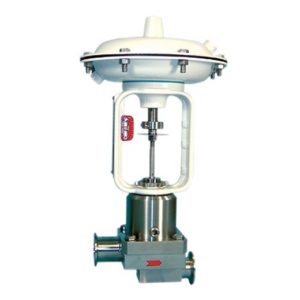MENUMENU
From this, the 84000 series diaphragm sanitary control was developed. As the industry grew and applications began to become more specialised and complex, Baumann again developed sanitary control valves to meet the market’s needs. In this case, the requirements were for two types of low-flow sanitary control valves to handle liquids with suspended media and pure gases. The 83000 and 87000 low flow sanitary control valves were the outcomes of these design efforts.
Each valve is unique and unmatched in the control valve industry for the low flow of sanitary media and is used exclusively by many Life Science and Food & Beverage manufacturers because no other valve can perform as well. Consumption continued to skyrocket for medicines and vaccines, and Life Science companies.
The Life Science industry standards differ from those that apply to conventional control valve designs because in many applications the process fluid will ultimately find itself inside the human body. The development of bacterial growth and the addition of foreign matter into the process fluid must be prevented.
If such contamination were to occur, the properties of the drug could change, running a multi-million-dollar batch and causing a costly shutdown of the facility.
The driving force behind the design of Bioprocessing equipment in the U.S. is the ASME-BPE (American Society of Mechanical Engineers – Bio Processing Equipment) group. This is a group of engineers, scientists, and marketing professionals with extensive industry knowledge from both end-users and equipment designers who determine the standards used around the world.
Another driving force is the EHEDG (European Hygienic Equipment & Design Group). They perform a similar function regarding hygienic equipment in the European Union, with a focus on Food and Beverage. However, their specifications are often required for Life Sciences projects located within the European Union. Process Related, the ASME-BPE group and EHEDG cover the design of equipment.
Other committees are focused on proper material usage and overall equipment processes and how these technologies are validated and implemented. The FDA (Food & Drug Administration) and USP (United States Pharmacopeia) groups perform these duties. The FDA has written current GMP (Good Manufacturing procedures) and PAT (Process Analytical Technology) guidelines for the industry. These guidelines outline the proper way to implement current technologies (cGMP) and the correct development and implementation process for new technologies (PAT). In addition to these guidelines, the FDA is interested in elastomer materials used in the industry. They have a list of approved materials that will not leach into the flow stream and possibly alter the composition of the drugs being produced.
The USP group is mainly concerned with the materials used in bioprocessing equipment and if they will cause abnormalities to living tissue, their testing involves implanting samples of the material in question into lab rats and evaluating the results. If there is no effect on the rat (cancer, cell mutation, etc.) then the material is acceptable. 